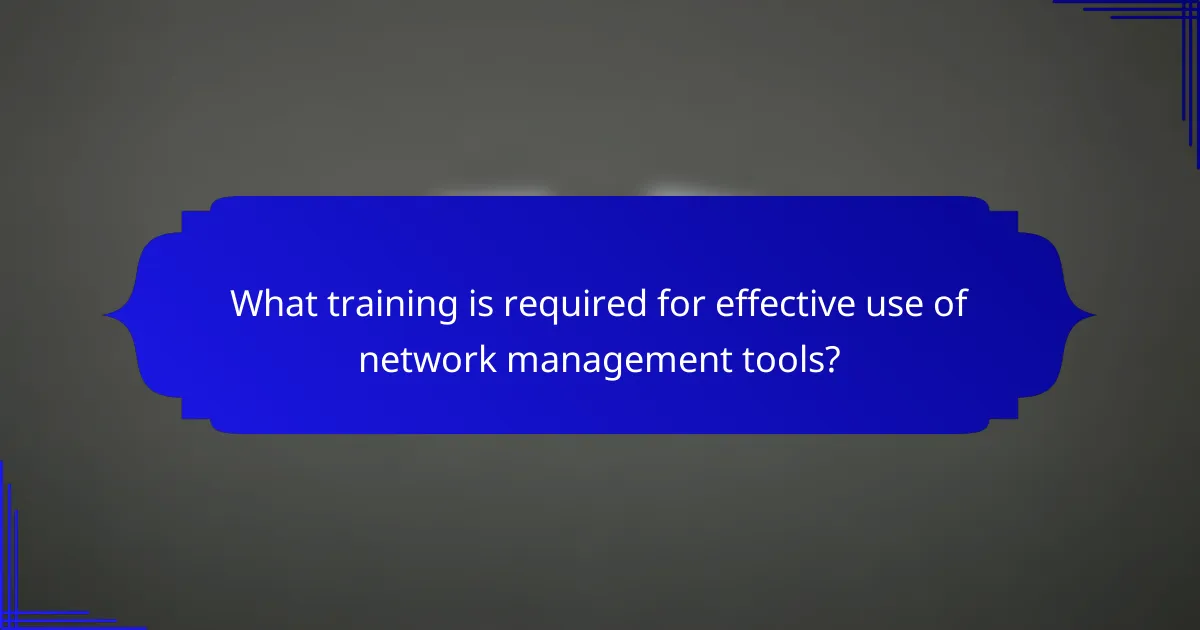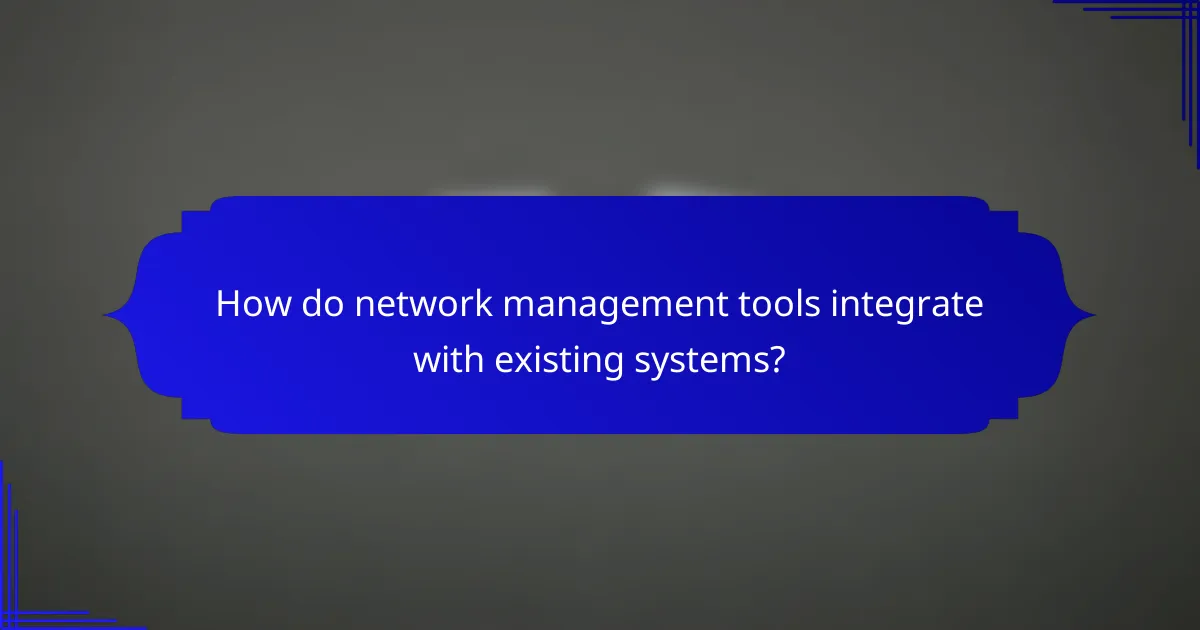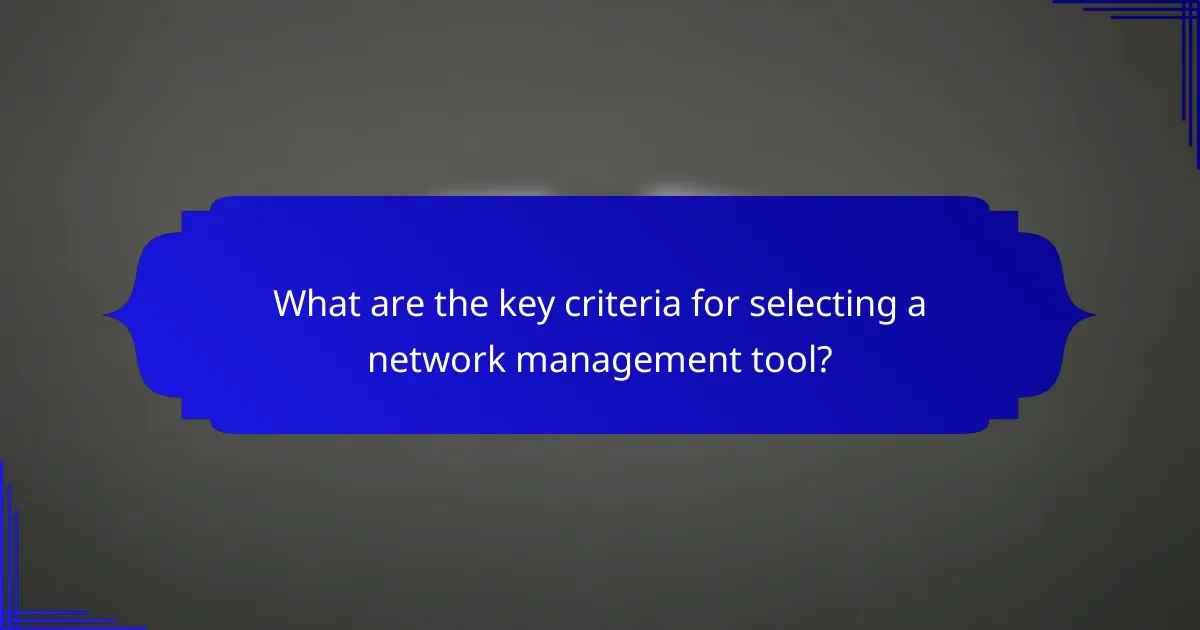Network management tools play a crucial role in enhancing the performance and security of organizational networks, offering solutions tailored to various needs. By automating routine tasks and providing centralized control, these tools help streamline operations and reduce errors. However, effective utilization often necessitates comprehensive training and integration strategies to navigate the complexities of network management.

What are the best network management tools in New Zealand?
The best network management tools in New Zealand include a variety of solutions that cater to different organizational needs, focusing on performance monitoring, security, and ease of integration. Key players in this market are known for their robust features and adaptability to local network environments.
SolarWinds Network Performance Monitor
SolarWinds Network Performance Monitor is a comprehensive tool designed for real-time network performance monitoring. It provides insights into network health, traffic patterns, and device performance, making it easier for IT teams to identify and resolve issues quickly.
This tool is particularly beneficial for organizations that require detailed analytics and customizable dashboards. Its user-friendly interface allows for efficient monitoring of both on-premises and cloud-based networks, which is essential for New Zealand businesses increasingly adopting hybrid infrastructures.
Palo Alto Networks Prisma Cloud
Palo Alto Networks Prisma Cloud is a security-focused network management tool that integrates security and compliance across cloud environments. It offers visibility into network traffic and helps organizations manage risks associated with cloud services.
For New Zealand businesses, Prisma Cloud ensures compliance with local regulations while providing advanced threat detection capabilities. Its ability to automate security policies can significantly reduce the burden on IT teams, allowing them to focus on strategic initiatives.
ManageEngine OpManager
ManageEngine OpManager is an all-in-one network monitoring solution that provides real-time insights into network performance and health. It supports a wide range of devices and applications, making it suitable for diverse IT environments.
This tool is particularly useful for New Zealand organizations that need to monitor both local and remote sites. OpManager’s customizable alerts and reporting features help teams proactively manage network issues before they escalate, ensuring minimal downtime.
Paessler PRTG Network Monitor
Paessler PRTG Network Monitor is a versatile tool that offers comprehensive monitoring capabilities for networks, servers, and applications. Its sensor-based architecture allows users to monitor a wide variety of metrics, from bandwidth usage to server uptime.
For businesses in New Zealand, PRTG provides an intuitive interface and easy setup, making it accessible for teams of all sizes. Its flexible licensing model allows organizations to scale their monitoring needs as they grow, making it a cost-effective solution.
NetCrunch
NetCrunch is a network management tool that focuses on real-time monitoring and alerting. It provides a visual representation of network topology, which helps IT teams quickly identify issues and understand network performance.
This tool is particularly advantageous for New Zealand companies that require a straightforward solution without extensive training. NetCrunch’s ability to integrate with various IT systems enhances its usability, allowing for streamlined operations and improved response times to network incidents.

How do network management tools reduce complexity?
Network management tools simplify operations by automating routine tasks, providing centralized control, and delivering insights through analytics. These features help network administrators manage resources more efficiently, reducing the potential for errors and streamlining workflows.
Automated monitoring features
Automated monitoring features continuously track network performance and health, allowing for proactive issue detection. By setting thresholds for alerts, these tools can notify administrators of potential problems before they escalate, minimizing downtime and service interruptions.
For example, a network management tool might automatically alert IT staff if bandwidth usage exceeds a certain percentage, enabling quick responses to potential bottlenecks. This proactive approach helps maintain optimal network performance and reliability.
Centralized management dashboards
Centralized management dashboards consolidate data from various network components into a single interface, simplifying oversight. Administrators can view the status of devices, traffic patterns, and performance metrics in one place, making it easier to identify issues and make informed decisions.
These dashboards often allow for customization, enabling users to prioritize the information most relevant to their operations. This feature helps reduce the complexity of managing multiple tools and interfaces, leading to more efficient network management.
Real-time analytics and reporting
Real-time analytics and reporting provide immediate insights into network performance, allowing for quick adjustments and strategic planning. By analyzing data as it is generated, network management tools can help identify trends and anomalies that may require attention.
For instance, real-time reports can highlight unusual traffic spikes or drops, enabling administrators to investigate and resolve issues promptly. This capability not only enhances operational efficiency but also supports long-term network optimization strategies.

What training is required for effective use of network management tools?
Effective use of network management tools typically requires a combination of vendor-specific training, online certification courses, and hands-on workshops. These training options help users understand the complexities of network management and ensure they can leverage the tools effectively in real-world scenarios.
Vendor-specific training programs
Vendor-specific training programs are designed to provide in-depth knowledge about particular network management tools offered by specific companies. These programs often include detailed instruction on the software’s features, capabilities, and best practices for implementation.
Consider enrolling in these programs if you primarily use tools from major vendors like Cisco, Juniper, or SolarWinds. They often offer both online and in-person training sessions, which can vary in duration from a few days to several weeks, depending on the complexity of the tool.
Online certification courses
Online certification courses are a flexible way to gain expertise in network management tools. These courses typically cover fundamental concepts, advanced techniques, and troubleshooting methods, allowing participants to learn at their own pace.
Look for certifications from recognized organizations such as CompTIA or Cisco. Many of these courses can be completed in a few weeks and often include assessments to validate your skills. They can also enhance your resume and demonstrate your commitment to professional development.
Hands-on workshops and labs
Hands-on workshops and labs provide practical experience with network management tools, which is essential for mastering their use. These sessions allow participants to work directly with the tools in simulated environments, reinforcing theoretical knowledge through real-world application.
Seek workshops that offer lab time, where you can practice configuring and managing networks. These sessions typically last a few hours to a couple of days and can be found through local tech schools, community colleges, or professional organizations. Engaging in these hands-on experiences can significantly boost your confidence and competence in using network management tools.

How do network management tools integrate with existing systems?
Network management tools integrate with existing systems by utilizing various protocols and interfaces that facilitate communication between different software and hardware components. This integration is crucial for ensuring seamless operation and data exchange across diverse network environments.
API support for third-party applications
API support is essential for integrating network management tools with third-party applications. Many tools provide RESTful APIs, allowing developers to connect and automate processes between systems. This flexibility enables organizations to customize their network management solutions and enhance functionality without extensive coding.
When selecting a network management tool, consider the availability and documentation of its API. Well-documented APIs simplify integration efforts and reduce the learning curve for developers, ensuring smoother implementation.
Compatibility with cloud services
Compatibility with cloud services is a key factor in modern network management. Tools that support cloud integration can manage resources across on-premises and cloud environments, providing a unified view of network performance. This capability is particularly important as businesses increasingly adopt hybrid cloud strategies.
To ensure compatibility, check if the network management tool supports major cloud platforms like AWS, Azure, or Google Cloud. Look for features such as automated scaling and real-time monitoring to enhance operational efficiency.
Integration with security tools
Integrating network management tools with security tools is vital for maintaining a secure network environment. This integration allows for real-time threat detection and response, as security incidents can be monitored alongside network performance metrics. A unified approach helps in identifying vulnerabilities and mitigating risks effectively.
When evaluating network management solutions, prioritize those that offer built-in security features or can easily connect with existing security systems, such as firewalls and intrusion detection systems. This ensures a comprehensive defense strategy against potential threats.

What are the key criteria for selecting a network management tool?
When selecting a network management tool, key criteria include scalability, cost-effectiveness, and user experience. These factors ensure that the tool can grow with your network, fit within budget constraints, and be easily navigated by users.
Scalability and flexibility
Scalability refers to a tool’s ability to handle increased network loads without performance degradation. A flexible tool can adapt to changing network architectures, whether you’re expanding your infrastructure or integrating new technologies.
Look for tools that support both vertical and horizontal scaling. For instance, a solution that can manage thousands of devices seamlessly is ideal for larger organizations. Additionally, consider whether the tool can integrate with cloud services or hybrid environments, which are increasingly common.
Cost-effectiveness and pricing models
Cost-effectiveness involves evaluating the total cost of ownership, including licensing, maintenance, and potential training expenses. Pricing models can vary significantly, with options such as one-time purchases, subscriptions, or usage-based fees.
When assessing costs, consider the long-term benefits of the tool. A slightly higher upfront cost may be justified by superior features or support. Compare different pricing models to find one that aligns with your budget and usage patterns, ensuring you account for any hidden fees.
User interface and experience
A user-friendly interface is crucial for effective network management. Tools should offer intuitive navigation and clear visualizations to help users quickly understand network status and performance metrics.
Evaluate the user experience through demos or trial versions. Look for customizable dashboards that allow users to prioritize information relevant to their roles. A well-designed interface can significantly reduce training time and improve overall efficiency in managing network operations.
